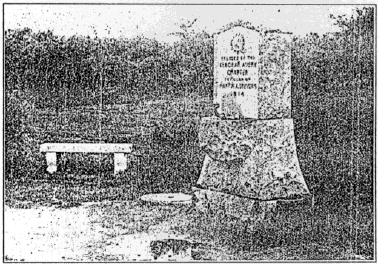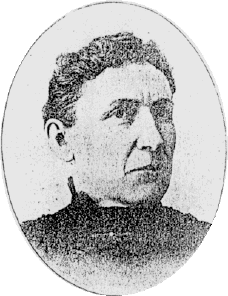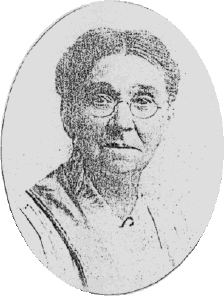
|
AND RECORD OF PIONEER DAYS Published Monthly by the Nebraska State Historical Society Editor, ADDISON E. SHELDON Associate Editors The Staffs of the Nebraska State Historical Society and Legislative Reference Bureau Subscription $2.00 Per Year q All sustaining members of the Nebraska State Historical Society receive Nebraska History without further payment. q Entered as second class mail matter, under act of July 16, 1894, at Lincoln, Nebraska, April 2, 1918.
The slanderous proclamation by Nebraska
newspapers that the well mannered snowstorm of April 3,
1920, was a blizzard because it was beneficently copious,
calls for some account of the real thing of April, 1873,
which began late in the afternoon of the 13th and lasted
with little abatement through three nights and days. The
1920 storm increased in violence in its eastward course - a
very common occurrence by the way - though it nowhere
deserved the name of superlative import. |
Northern Pacific railroad, on June 14, 1872. but was
called Fort McKeen until November 19, 1972. Bismarck was
just getting a start not far above on the opposite side.
Fort Rice was established July 11, 1864, on the west bank of
the river, about twenty miles in a direct line below the
subsequent site of Fort Abraham Lincoln. This regiment was
part of the Yellowstone Expedition which was sent to
establish a depot of supplies at a point on the projected
line of the railroad near the confluence of Powder river
with the Yellowstone. The site chosen was at the mouth of
Glendive Creek, now within Dawson county, Montana, near its
eastern boundary. The Northern Pacific railroad, in its
westward course, first struck the Yellowstone at this point.
The town of Glendive, on the same site, is the capital of
Dawson county. |
|
2 |
|
|
ing the "fearful storm" but a thousand head of cattle and
a few horses, mules, sheep and chickens succumbed. The ratio
of losses of cattle was not greater than in other parts of
the path of the storm. H. A. Gerrard & Co. erected a
temporary fence above the original fence of their corral, on
the side where the snow got up to the top of it, and thus
kept the cattle from getting out and drifting to destruction
with the storm; and notwithstanding that there was no
shelter in the enclosure, they all survived. There were no
losses where good care was taken. The Journal called it "the
terrific storm of April 14th, 15th and 16th." It also copied
from the Kearney Press a statement that a woman who
lived fifteen miles northeast of the town, whose husband was
absent at Grand Island, perished in an attempt to reach a
neighbor's house after the roof of her own fell in. A boy
about fifteen years old started from the office of the Lone
Tree Sentinel on an errand to a place only twenty rods away.
he was found dead in the Platte River a mile and a half
distant. Heavy losses of stock were reported from Colfax
county.
Copy of notes made by the Smithsonian
Institution Observer, at Santee Indian Agency, Nebraska,
relative to the severe storm, April 13-16, 1873. |
wind N., barometer rising, weather, Hy. Snow. ALBERT WATKINS. First Capital of Red Willow County A historical sketch entitled The Beginnings of Red Willow County, printed in volume XIX of the publications of the Historical Society, contains an account of the struggle for the county seat between Indianola and Red Willow. Senator John H. Cordeal supplied valuable material for the history, obtained from the county records. The election for locating the county seat and for choosing the first county officers was held on May 27, 1873. The canvassers found in favor of Indianola, both in respect to the county seat and the candidates for county offices nominated by the partisans of Indianola; whereupon the Red Willow faction brought suit in the court of George W. Colvin, a justice of the peace at Arapahoe, then the county seat at Furnas county, praying for a reversal of the count of the canvassers. On August 1, 1873, the justice found for Red Willow, but the decision was appealed to the district court, whereupon the Red Willow party gave up the county records and yielded the offices to the appellants. Quite recently Sen- |
|
|
3 |
|
NEBRASKA SOCIETY DAUGHTERS |
 |
|
|
|
|
Memorial Fountain and Seat |
|
The National Society, Daughters of the American
Revolution, organized in Washington, October 11, 1890, with
a charter membership of 818, now numbers more than 102,000.
The dream of the pioneers of this organization has come true
in a manner exceeding the hopes of even the most optimistic.
Memorial Continental Hall, the home of the society in
Washington, is one of the show places of the capital. It is
valued at more than one million dollars and is held under
charter granted by the United States government the only one
of its kind granted to any patriotic society. and is free
from taxation by special act of Congress because of the aims
and purposes of the society in promoting ideals of public
service and patriotism. Memorial Continental Hall is unique
because it is a memorial by women to the men and women of
the stirring revolutionary times. Many of the most important
meetings in Washington for the advancement of historical
research, scientific investigation and sociological study
are held in Continental Hall. 
MARY M. A. STEVENS had its beginning when Deborah Avery Chapter was organized May 15, 1896, at Lincoln and chartered by the National Society on June 17. The Omaha chapter was formed on June 29th and chartered by the National Society on October let of the same year. Mary M. A. Stevens was the first regent of Deborah Avery Chapter and Mrs. Laura B. Pound, appointed in May, 1806, was the first state regent for Nebraska. Mrs. Frances Avery Haggard of Lincoln was elected state regent in 1898 and was followed by Mrs. Elizabeth Towle of Omaha. In 1901 Mrs. Pound was again elected and served two terms. She called the first state conference in October 1902 which was held in Lincoln at the home of Mrs. Addison S. Tibbets. The main purpose of the conference was to arrange for celebrating the centennial of the Lewis and Clark ex- |
pedition. The anniversary of the council of Lewis and
Clark with the Oto and Missouri Indians was observed August
3, 1904, and a Nebraska boulder was dedicated at Fort
Calhoun with appropriate exercises, participated in by the
Sons of the American Revolution and the Nebraska State
Historical Society. This was the first historical event
commemorated by the Daughters in Nebraska. 
MRS. S. B. POUND the trail crosses the line into Wyoming. |
|
4 |
|
Vol III, no 2
Return to NE History & Record of Pioneer Days
© 1998, 1999, 2000, 2001 for NEGenWeb Project by Ted & Carole Miller
